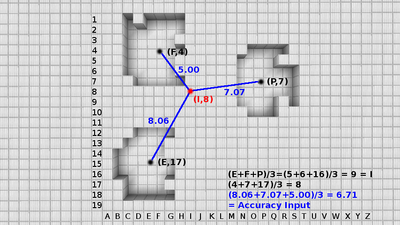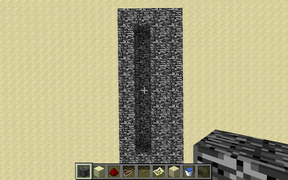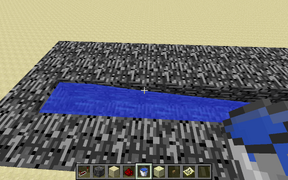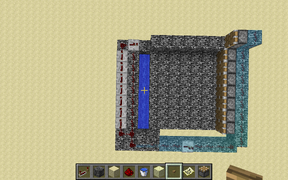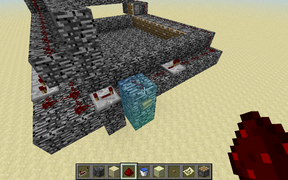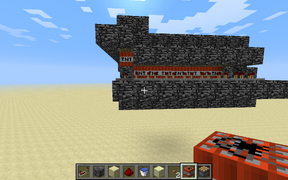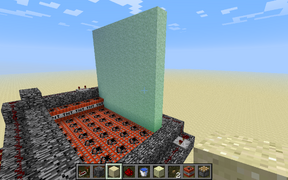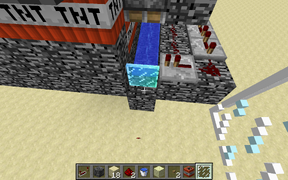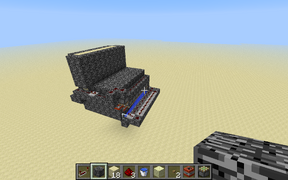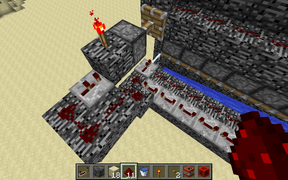Engineer314 (トーク | 投稿記録) (→技術的名称) タグ: モバイル編集 モバイルウェブ編集 |
Engineer314 (トーク | 投稿記録) (誤字訂正) タグ: モバイル編集 モバイルウェブ編集 |
||
| 99行目: | 99行目: | ||
* その後、リピーター数と設定されている遅延をリストする。例えば、4ティック(最大遅延)の[[レッドストーンリピーター]]が10個ある場合、R4.10と表記する。 [[レッドストーンリピーター]]がない場合は手動でMを作成する。 |
* その後、リピーター数と設定されている遅延をリストする。例えば、4ティック(最大遅延)の[[レッドストーンリピーター]]が10個ある場合、R4.10と表記する。 [[レッドストーンリピーター]]がない場合は手動でMを作成する。 |
||
* 取り付けブロックはコードで指定する : |
* 取り付けブロックはコードで指定する : |
||
| − | ブロックなしの場合は0又は1、フルブロックは2、[[ハーフブロック]]は3、[[はしご]]、[[ガラス板]]、[[鉄格子]]は4、[[トラップドア]]は5、[[フェンス]]、[[感圧 |
+ | ブロックなしの場合は0又は1、フルブロックは2、[[ハーフブロック]]は3、[[はしご]]、[[ガラス板]]、[[鉄格子]]は4、[[トラップドア]]は5、[[フェンス]]、[[感圧板]]は6、[[ピストン]]は7。 |
* キャノンが特殊な射撃(垂直射撃など)を行う場合、又は広角射撃を行う場合は取り付けブロックコードを書き込んだ後にそれを書き足す。 |
* キャノンが特殊な射撃(垂直射撃など)を行う場合、又は広角射撃を行う場合は取り付けブロックコードを書き込んだ後にそれを書き足す。 |
||
* そして、キャノンのニックネームはもちろんここに来る。 |
* そして、キャノンのニックネームはもちろんここに来る。 |
||
2019年12月14日 (土) 04:10時点における版
3
TNTキャノン (TNT cannon) は、TNT あるいは爆発を引き起こすエンティティの爆風によって TNT や TNT付きトロッコを発射させる装置である。
概要
ここではTNT炸薬でTNT弾頭を発射する旧式のキャノンについて解説しています。1.8以上ではスライムブロックでTNTを打ち上げるTNTキャノンを作ることも可能です。
構成
- 本体
- 配線
- 着火用
- 着火後の1箇所への収集用
- 発射用
- その他
- 着火用
- 爆発物
- 発射に必要なエネルギー用
- 発射用
- 爆発耐性に優れた外装
- その他ブロック
基本概念
- TNTキャノンはTNTが水中で爆発した場合、ブロックを破壊しないという仕様を基に作動する。通常、TNT等の着火にはレッドストーンが用いられる (まず炸薬に着火し、信号を遅延させて弾頭に着火する)。
- プレイヤー、モブ、TNT、矢、砂や砂利、金床など、ほとんどのエンティティを弾頭として使用できる。射撃の際は弾頭が水に着弾しないようにする(耐水弾を使用していない場合)。
- 炸薬とは、弾頭を発射するためのTNTである。
- テストの際は、着弾点に水を設置する。景観が破壊され、モブもダメージを受ける。
- 適正に射撃するために(そしてキャノンの自爆を避けるために)弾頭に着火する前に炸薬に着火する必要がある。
- 炸薬は水に漬けられている為キャノンは破壊されないが、弾頭は水に漬けられていない為ブロックを破壊しモブにダメージを与える。
- 別の箇所で説明している通り、レッドストーンは爆縮用炸薬を除く全ての炸薬を同時に着火するために使用する。
- 射程を最大まで伸ばすには、射角を約30度に設定し、炸薬と弾頭の距離をできるだけ近づけて炸薬の爆風を最大限に弾頭へ伝える必要がある。
- さらに射程を伸ばしたい場合は、高い位置にTNTキャノンを作ると良い。
- 矢、砂や砂利、金床、またはモブを弾頭として使用する場合はピストンで落とす必要がある。
これは、基本的な TNTキャノンのチュートリアル動画である。
キャノンの名前
命名の一般的な方法は二種類ある。「一般名称」はTNTキャノンの性能を示し、「技術名称」はレッドストーンの遅延などを示す。 しかしこれらは欧米の命名方法であり、日本での一般的な名前は現実の兵器に似せて命名する。場合によっては、キャノンの種類が名前になる場合がある。 ここでは欧米の命名方法について解説する。
一般名称
一般名称はTNTキャノンの性能を示す。これは二種類のTNTキャノンの性能を比較するときに便利であり、名前を見るだけで基本的な性能を知ることができる。
ダメージ量、コスト、弾頭数、有効射程とニックネームを下のテンプレートに当てはめて名付る。
<ダメージ量>.<作成難度>:<弾頭数>.<有効射程> <ニックネーム>
例: 40.86:8.104 榴弾砲
- ダメージ量
ダメージ量はキャノンがどれだけ「良い」かを示し、値が大きいほど優れている。
精度値は精度から算出される。これは、弾頭の爆発からその位置までの距離の平均である。
画像では、精度は青い線の長さの平均である。 赤い点は爆発の位置の平均であり、青い線の終点である。他は爆発線。精度値の式は (45-A)*2ここで、Aが精度である。
パワー値は弾頭数に10を掛けたものである。
速度はキャノンの前面から爆発の中心までの距離の平均である。 速度値の式はS/5である。Sが速度。
損傷値はこの式を用いて算出する: (((45 - A)*2) + (P*10) + (S/5)) / 3
- 人間工学値
人間工学値はキャノンの建設がどれだけ難しいかを示し、値が大きいほど簡単に 建設出来ることを意味する。これは、構築値、レッドストーン値及びTNT値の平均である。
構築値は、火、水、空気、TNTを除く、キャノンのブロック数の推定値である。算出には (1000 - B)/10 を用いる。Bが構築値であると仮定する。
レッドストーン値はレッドストーンの複雑さの1~10の推定値から10を引いたものである。; (10-R)*10 Rが推定値。
TNT値は (50 - T) * 2 で、Tはキャノンをフル稼働させる為に必要なTNTの数を表す。
EVを計算する方程式の全体は ((1000 - B)/10 + ((10 - R)*10) + ((50 - T)*2)) / 3 である。
- その他
弾頭数、有効射程、ニックネームは一目瞭然だが、より明確にするために、EVのTNT値と同じであるTA、キャノンの前面から最も遠い場所での爆発までの距離であるMRを追加する。
下品でないことや、他のキャノンのニックネームと被らないことを前提に、どんなニックネームを名付けてもよい。
これが 40.86:8.104 Basic Canonの名前の由来である。
ダメージ値 = (((45 - 0)*2) + (1*10) + (104/5)) / 3 = 40 人間工学値 = ((1000 - 50)/10 + ((10 - 2)*10) + ((50 - 8)*2)) / 3 = 86 40.80:8.104 Basic
技術的名称
技術的名称は、機能、用途、操作方法を示す。While it is impossible to anticipate every innovation in TNT cannon technologies, most cannons will benefit from using these standards in their technical names.
- 技術的名称の最初の数字は、炸薬用の垂直列の数である。 例のキャノンでは1。
- 次の数は、弾頭数である。繰り返すが例のキャノンでは1。
- 次の数は炸薬数である。
- 爆縮システム搭載の場合、炸薬数を書き込んだ後、小数点を書き、爆縮用炸薬数を書き込む。搭載していない場合は0を書き込む。
- その後、リピーター数と設定されている遅延をリストする。例えば、4ティック(最大遅延)のレッドストーンリピーターが10個ある場合、R4.10と表記する。 レッドストーンリピーターがない場合は手動でMを作成する。
- 取り付けブロックはコードで指定する :
ブロックなしの場合は0又は1、フルブロックは2、ハーフブロックは3、はしご、ガラス板、鉄格子は4、トラップドアは5、フェンス、感圧板は6、ピストンは7。
- キャノンが特殊な射撃(垂直射撃など)を行う場合、又は広角射撃を行う場合は取り付けブロックコードを書き込んだ後にそれを書き足す。
- そして、キャノンのニックネームはもちろんここに来る。
上記のTNTキャノンは「114.0R4.4M2」という名前になる。
建設に必要な材料
サバイバルモード
概要で説明した通り、TNTキャノンは多くの部品から成り立っている。ここでは建設に必要なものを示す。
1. 本体
- 丸石など一般的なブロックを使用する。
- もうひとつの要項は可視性である。 黒曜石で本体を作る際は、レッドストーンダストが見えにくく、これが致命的なミスへ繋がる可能性がある。 一方、森などで待ち伏せを想定している場合は、オレンジの羊毛やラピスラズリブロックなど、目立つブロックの使用は避ける。
2. 配線
- 炸薬に着火する配線と弾頭に着火する配線の、主要な2つの配線がある。
- レッドストーンリピーターがない場合、ボタンなどの2つの動力源を手動で操作する。 手動で操作する場合、弾頭用のドロッパーに接続する回路と、炸薬に着火する回路だけでいい。ただし、誤射を防ぐためにそれぞれのボタンを押すタイミングを計らなければならない。
- レッドストーンリピーターを使う場合は別の話になる。炸薬に着火してから弾頭に着火するまでの時間は40ティック(最大遅延のレッドストーンリピーター×10)である。 1つの動力源だけを使用し、操作も手動より簡単である。
3. 取り付けブロック
- 取り付けブロック(以下で説明)は特殊なブロックのみである。
4. 耐爆カバー
クリエイティブモード
クリエイティブモードでは、戦争用にTNTキャノンを建設する理由はないが、テストと開発に適している。
Factions
In factions raiding with TNT cannons is the most common way of getting into a base. There are two main methods. st. This only works on obsidian with wateThe first(on servers where enabled) is to airburr outside. The cannon shot must have a delay so the explosion reaches the obsidian but the primed TNT must not be in the water. These cannons will not work on other walls. The other method is with hybrid cannons which are explained below. The basic hybrid is one of the most commonly used raiding cannons.
制限及びそれらを解除する方法
TNTキャノンのエンジニアリングにおける5つの制限は以下の通り:
1. 何をしてもTNTは着火されてから約4秒間、8回点滅する。
- これを回避するにはTNTをより速く飛ばす必要があるが、これによって制限が2になる。
2. エンティティが脱出速度で飛行するとマインクラフトがクラッシュする可能性がある。マインクラフトのクラッシュを引き起こす可能性のあるもうひとつのことは、大量の炸薬が同時に爆発することである。
- 割り当てられた1.5GBのRAMで、TNTの最大数は約500である。これを回避する方法は、マインクラフトに許可されているRAMを増やすことだが、低スペックのコンピューターには推奨できない。
3. TNTの爆発範囲は7ブロックなので、大きなキャノンを作るだけでは無駄である。弾頭と炸薬の距離が9ブロックを超えると、無駄な爆発が発生する。
- これは垂直機構を追加するか、圧縮システムを採用するか、又は両方を組み合わせる事で回避できる。
4. 着火されたTNTは水流に流される。これは状況に応じて、いい場合も悪い場合もある。
- 水源にすることで回避出来る。
5. 垂直機構を強化し過ぎると弾速が速くなり過ぎて、ゲームがクラッシュする。
- キャノンの威力を落とすか、半垂直にすることで回避できる。
キャノンのサイズと特別な機能
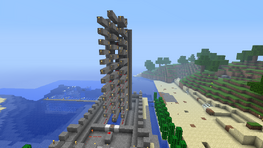
An example of a super large cannon
キャノンのサイズのデフォルトの定義は、 弾頭数又は射程距離である。小規模なキャノンについて話している場合は 、キャノンのサイズ(例えばそれが占めるスペース)で、大量破壊兵器について話している場合は、弾頭数であるかもしれない。しかし、多くの場合は炸薬数である。
112.0MM3 などの小型のキャノンは、射程が非常に狭い。対人用。
116.0R4.6M2 などの中型のキャノンは、最初のラインシージャー(その後の射撃のための目安)として設定し、物資や壁などのターゲットへ向けて、矢のカバーを付けて設定するか、ターゲットとして設定することを目的としている。射手キャノン。
119.0R4.10M3 などの大型のキャノンは、遠くからの攻撃、国境からの長距離迫撃砲、対キャノン防御、2番目のラインシージャー、その他の多くの用途に使用する。
A sniper cannon, such as the 119.3R4.10M6 is for a tent line sieger, setting up to shell opponents camp when they can't even see the cannon shelling them, and other out-of-sight range tasks such as that.
そして、 187.0MM6 広角砲などの大規模なデモキャノンは、あらゆるボタンシステムを完全に破壊するために使用される。
次のような機能をキャノンに追加できる:
- 複数の弾頭 [1]
- 半自動/全自動の発射とリロード[2] [3]
- 爆縮用炸薬(メインの炸薬とは別のTNTで、炸薬を弾頭の方へ押し出して弾頭を増加させる)
- 安全装置
- 調整可能な弾頭用遅延。射程と弾頭を変更できる
- 代替弾頭[4]
- ドライキャノン : 爆発耐性の高いブロックでキャノンを建設して、設計、管理を簡略化し、有効射程を伸ばしたキャノン。 建設についての詳細は below
- 矢を弾丸として
- 上方向や斜め方向など特殊な方向へ発射するキャノン
- 照準可能なキャノン
- 散弾、大量破壊砲。
- 爆風シールド付きのキャノン (TNTが水没し、爆発時にブロックを破壊しない場合でも、エンティティはダメージを受ける)
- 散弾銃用の炸薬。
- 金床のキャノン
圧縮システム
TNTベースの圧縮
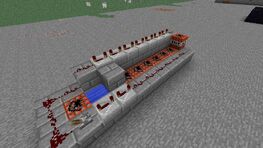
An example cannon with a Condenser Charge.
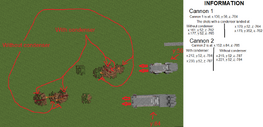
A comparison of the shot distance of two different cannons, 1 shot with and 1 shot without a condenser charge each.
弾頭と炸薬の距離が7ブロック以上離れている場合、ほとんど意味がなくなる。これを解決するには、炸薬を圧縮する必要がある。
圧縮用炸薬をメインの炸薬より少し前に起爆させ、その爆風によってメインの炸薬を弾頭の方へ押し出す機構である。 これにより、弾頭と炸薬の距離が短くなるため、弾速が増す。 通称:爆縮システム
ピストンベースの圧縮
ピストンを使用して、炸薬を弾頭に近づける。複雑になるが制御しやすい。 To work, the main charge must be primed, turning the solid TNT blocks into entities. TNTに着火した後、一連のピストンで全ての炸薬を押して、弾頭の後ろの単一のスペースに圧縮することが出来る。
この機構を用いることで、同じ炸薬数でも格段に弾速が増す。[5]
Care must be taken so that the pistons do not displace the water blocks protecting the cannon from TNT damage. To do this, one usually has to apply water a block above the area where the pistons would go into. It is also advised that the pistons should retract back into normal position before the main charge explodes, or your cannon might be destroyed. When the pistons extend, they create air spaces in the water no matter what, hence compromising the water's protection.
ガイドブック
When a TNT charge is primed, it will usually shift slightly to one side. This can make a previously great cannon inaccurate. This is true with many cannons; but the solution is simple. If you add a guide block to the cannon, so that there is a wall on either side of the TNT when it is primed, it will not shift left or right, making an otherwise straight shot diagonal. If your design does not allow for this, you could just make the guide blocks one block higher, instead of being on either side of the TNT. This works because TNT will jump up, then go sideways in midair. Note that in most basic cannons, guide blocks should be transparent if the TNT cannon automatically primes the shot-otherwise, the redstone that ignites the charge will power the block next to the shot, and igniting the shot as well. If this explanation is unclear, look at this diagram:
In dry cannons, a guide block is almost a necessity because dry cannons tend to be inaccurate. However, dry cannon's guides are for directing the shot to be shot accurately, not to be primed accurately. However, guides can also decrease range if they are too long.
Shot mounting blocks
The shot mounting block for a cannon should be chosen according to how fast, far, and high you want the cannon to fire. Of course, these variables depend greatly on the position and amount of the charge and the timing of the shot, but the mounting block also can make a difference. For example, with a cannon with a charge of 5 and a delay of R4.3, the shot will take a mortar trajectory with a ladder more than with a fence post and pressure plate.
A few things:
- Even though the shot mounting blocks ladder and full block are both the same height and fire a shot at the same trajectory, the ladder will consistently fire farther than the full block because the ladder has less matter in between the shot and the charge than the full block. This situation is the same for all mounting blocks, the slab and fence post with pressure plate also follow the same rule.
- There is a trade off: although the fence post and pressure plate fire the farthest, they are also expensive, while the slab is cheap and easy to get, as well as coming in many forms.
- The maximum range for any cannon can be achieved by altering the mounting block. A TNT shot will be fired farthest if it leaves the cannon at a 30 degree angle. So, if you want to just have your cannon go the farthest it can, use the slab, fence and pressure plate, or trapdoor mounting blocks. However, when faced with fortifications or terrain obstacles, the best idea would be to have a mounting block like piston, ladder, or single block that makes the TNT arc over the said obstacle. But, then again, it is fun to blast your way through things...
- The following shot mounting blocks are tested and deemed safe. Feel free to experiment with mounting blocks, but keep in mind that some blocks, such as a lone pressure plate, will cause a mis fire of your cannon, and of course make it self-destruct.
A rewrite for most of these mounting blocks is coming soon.
Note: The pictures were taken with a resource pack.
取り付けブロックなし

No Mounting Block
Pros: Highest velocity, simple, scalable
Cons: poor range in smaller cannons, downward trajectory, line-of-sight only
When no mounting block is used, the shot is launched from the same level as the TNT. It will fire out completely horizontal, or 0°. Gravity will quickly pull the shot to the ground, giving a very flat, downwards trajectory.
With small TNT charges, the range can be extremely limited. To increase the range, ever larger charges are needed or the cannon must be built higher above the ground. A larger charge means a higher velocity to the shot, pushing it farther away before it drops to the ground.
Players have been known to use up to 70 TNT charges and beyond. But economically, a cannon without a mounting block will take more TNT and longer to load for a certain range.
単一のブロック

Single solid mounting block
Pros: Higher firing angle, can lob shots
Cons: Low velocity, reduced power and poor range for smaller cannons
A single full size block such as cobblestone or obsidian is placed under the Shot. This has the effect of elevating the Shot above the water trough, so the blast force from the Charge is applied not just forward, but upwards. The shot is fired out at a high angle and trajectory. This is useful for hitting an elevated target, or one behind terrain or obstruction.
However, part of the blast force is absorbed by a solid mounting block, so the cannon will suffer similar problems of needing large charge sizes. Also, since some of the energy is expelled in the upwards direction, forward shot velocity is reduced greatly.
A better alternative to the single mounting block is using a ladder instead.
ハーフブロック
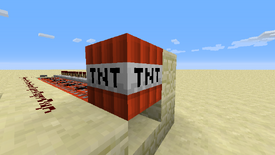
Stone slab used as a half block mounting
Pros: Smooth trajectory (not too high, not too low), average velocity, more efficient for small and medium cannons
Cons: Slightly reduced power, not best for either straight or lob shots, fuse range limit*
A slab is the compromise between a single block and no mounting, and generally more efficient than either. More of a cannon's blast force is directed forward, but there is still an upward vector that raises the angle of fire to roughly 30°. As with a single block, some of the blast energy is absorbed by the block, but much less. From the same TNT load, the half block has greater range than a single block or no block.
When the TNT shot is initially placed over a half block, it will hang over it as if it was a full size block. Once the TNT has been "primed", it will fall down and sit on the true height of the slab.
The firing angle produced by a half block is good for extending the range of a cannon and hitting elevated targets, but its too low for effective lobbing over high walls and obstacles. For straight direct firing, shots fired with a half block mounting generally land level on the ground within a certain range. However, due to the limited fuse time of TNT in the game, scaling up the TNT charges up to a point will result in the shot flying too high and exploding in the air before it lands or reach the cannon's maximum range. This will be refer to as the "fuse range limit". All cannons are limited by the fuse range limit, but cannons firing at higher angles are especially prone to the fuse limit, as the shot velocity is lower and shots reach higher altitudes.
トラップドア
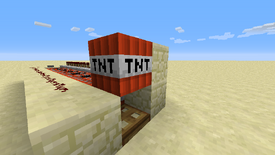
Trapdoor used as a mounting block
Pros: (closed) Optimized for flat trajectory, velocity almost the same as no-block, have a very large range meaning it can destroy far targets, (opened) can be used in open position for higher firing angle, good scaling, can destroy higher targets
Cons: Be sure that priming circuit doesn't activate the trapdoor by accident. Very high speeds and oversized accurate shots could mean that if the primed TNT hits a nearby wall in the air, it will fall down and miss the shot. It cannot aim at medium or high elevated targets
If the firing angle of the half block is too high for your purpose, a closed trapdoor can be used instead. Like the half block, it provides some upward force to the shot by elevating it above the trough. A trapdoor's height, however, is 3⁄16th of a full block. Firing angle is roughly 15-20°, making it extremely effective for straight shots at very long range (180+ blocks).
Little forward velocity is lost when firing, and shot typically fly out at very high speeds. This combine with the low firing angle means cannons firing larger loads can extend their range without encountering too much fuse range problems as with the half block or ladder mounting.
はしご / 鉄柵 / ガラス板
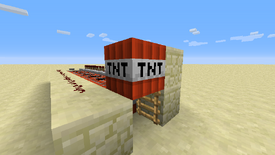
Ladder mounting block

Shot mounting with two ladders
Pros: Efficient with small and medium cannons, high firing angle, parabolic trajectory, good for lobbing shots and high altitude
Cons: Low horizontal speed, poor scaling, limited range at ±120 blocks
A ladder placed on the side can serve as a very effective mounting block for firing at high angles and lobbing shots. A primed shot will be supported by the edge thickness of the ladder, preventing it from falling into the trough. Because a ladder is not a full size block, none of the energy from the blast is absorbed, and the shot is propelled out at full force. By adding ladders above each other, different firing angles can be achieved. Typically, a single ladder will give an angle just higher than a half block, roughly 40°-45°. Two ladders will give an extremely parabolic flight, shots fly out at about 50°-60°.
A good portion of the blast energy is directed upwards on the block, so horizontal speeds are generally much slower than a no-mount or half block mount cannon. In return, the cannon has no problem lobbing shots over terrain and walls. At larger charge loads, shots can reach very high altitudes.
However, this also means the fuse range limit is an inherent problem with this mounting. Within a 100 block distance, well built cannons level with the ground can expect to land shots low enough to cause damage. But beyond this shots explode midair way beforehand, even with a shot primed at maximum fuse time with a delay circuit. Hence, one can't simply add more TNT to increase the range, as it will only make the shot fly higher. A basic solution is to put the cannon below ground, in a pit with a slanted slope to allow the shot to fly out. Since the shot had a lower starting point, it will explode closer to the ground once its fuse time runs out. To reach ranges beyond 150 blocks, this solution becomes impractical.
フェンス
Pros: Efficient with small and medium cannons, low firing angle, good for shooting through caves and past overhanging base defenses. High velocity, extremely powerful in spread cannons and long range cannons.
Cons: Expensive materials, fuse range limit to bigger cannons. If used a condenser, then the explosion will send the TNT too high and with no ceiling, the TNT can destroy the cannon.
A fence placed at the end of the cannon tricks Minecraft to think that it is one block high, since it is only one and a half block high for the player's perspective. Therefore, the charge would be recognized as closer to the shot than it actually is. Since it gains more power and velocity, it appears to fly up a bit, then go down in an attack angle. However, the explosion launches the TNT upwards meaning if the cannon has no ceiling, the TNT can well destroy the cannon. This gives it a distinctive style of cannon shooting, and it is considered one of the most useful mounting blocks in Minecraft.
if the cannon needs the water blocked a pressure plate may be used, but slightly decreases the launch velocity.
ピストン
A TNT cannon with piston mounting.
Pros: Adjustable, when fully extended it has the same effects of a full block but is more efficient than it and is more versatile, compatible with firing sand or gravel.
Cons: Expensive, the shot has been subject to the fuse range delay limit found in arcing cannons, is used as a mortar MB so usage inside caves or buildings is not recommended and will result in short range shots, accidentally placing two TNT blocks (one on top of the other) will destroy the cannon, requires a R4.7 delay.
The three most common ways to use this mounting block are
- Prime the shot then push it up
- Push it up and then prime the shot
- Just use it as a more efficient version of the full block MB.
珍しい取り付けブロック
植木鉢
Pros: Can lob shots
Cons: Fuse range limit, expensive, cannot aim at lower targets
レッドストーンリピーター
Pros: Second highest velocity
Cons: Can only shoot 9 blocks, expensive, make sure the circuit doesn't activate it by accident
This cannon is only used in an extreme hills biome. It only works if the cannon is on a cliff and the target is below it. It is the second worst cannon.
日照センサー
Pros: Good shooting, not too high velocity, can lob shots
Cons: Make sure the sensor doesn't activate the circuit by accident by daylight, expensive
This is a cannon for ground levels and it is good on any type of cannon (except of super large cannons which has a fuse range limit.
ベッド
Pros: Good shooting, really fast, medium-high angle
Cons: Expensive, bigger cannon
This is good for attacking bigger castles, but has also a big range. One of the best mounting blocks.
ケーキ
Pros: Good shooting, medium angle, big range
Cons: Expensive, cannot be retrieved
This mounting block is good for attacking far targets if you have resources. It has smaller footprint which means that charge TNT can be closer to the shot than when using slabs, thus increasing the range.
キャノンのチュートリアル
ディスペンサーベースのキャノン
Since the Redstone Update, redstone dispensers will dispense ignited TNT instead of the item. This feature can be used to make a new form of TNT cannons.
Example:
This cannon would have dispensers that release TNT into the water. Redstone would run on top of the dispensers. A 33-tick delay would keep the shot in the dispenser until the last possible moment. Another dispenser would place the TNT shot right before the charge detonates, giving the shot the most amount of airborne time possible. Dispensers dispense TNT without the characteristic "hop" of ignited TNT, which effectively guarantees the TNT will land in a much shorter radius than a conventional TNT cannon.
One of the smallest TNT cannons is this design by Mumbo Jumbo:
You can easily modify it to have another dispenser under the water facing up, and you can use a fence post with a pressure plate on top instead of a slab.
Pros: The time taken to reload TNT is at its absolute minimum. All a player has to do is to make sure the next shot is placed after the first shot is fired to make sure you don't destroy your cannon. This cannon requires little skill at all to fire; the hardest part will be placing the cannon a proper distance away to make sure you don't over/under-shoot. Such precision makes this cannon good for castle defense. Furthermore, through use of comparators, it is possible to make an easily aim-able dispenser-based cannon, and dispenser-based cannons do not blow themselves up if hit with another TNT cannon.
Cons: Dispensers and TNT are expensive. This type of cannon can never be quite as hardy as manual cannons, since dispensers can be blown up with TNT. Furthermore, if the cannon is left loaded and unattended, it is trivial to steal the TNT from its magazine. (This is also true of conventional auto-cannons.) Dispenser-based cannons with a one-block-wide water pool have also been known to blow themselves up, particularly if left firing automatically and unattended.
An automatic cannon can easily be made with this design. Substitute the button for redstone and hook the redstone up to a clock. Be careful not to set the clock under 4 seconds, the same time as it would take the TNT to explode. If the TNT is reloaded too quickly, the timing can cause the shot to detonate before the propellant does, destroying the entire cannon.
キャノンのリロード
伝統的な手法
Reloading cannons are one of the most complex designs for beginners. However, as long as close attention is payed, for a first time build, it can be created in about 15–20 minutes depending on the size. Reloading cannons became obsolete when dispensers were added (except in the console editions).
The Good: Reloading TNT cannons can be customized just as easily as any other cannon (using fences, iron bars, glass panes, etc.). They can be shot several times with only a few seconds' interval in opposition to having to reload it several times like you'd have to do with a standard TNT cannon. Using the simple design, this TNT cannon can have up to 12 rounds in the magazine. If playing a fortress war server, this cannon can fire repeated shots which will demolish the enemies' buildings before they have time to stuff their ammunition into their puny and inferior weapons.
The Bad: Unfortunately, cannons of this variety are bulky and often unattractive. They require sand or gravel which are nonrenewable resources in survival mode. Added to that, it is tedious to reload the cannons whenever the magazines run out of ammo, however occasional that may be. With standard TNT cannons, if the 1-round magazine is destroyed, it is usually easily replaceable. This is not the case with the reloading kind, as the entire magazine will explode, destroying the weapon and all the redstone wiring with it—often killing you in the process. This type of cannon has also become redundant with the recent updates allowing automatic cannons utilizing dispensers to reload the tnt, which is easier and more compact to make.
Step 6. Touch up & check for problems. I purposefully planted a few problems. First, some of the wiring is in the way of the barrel which will severely damage the range. We'll get to that later. More importantly, we need to move one of the repeaters ahead because it isn't providing enough power from where it is. Step 7. Load the magazine. Pay close attention to this part as you will have to do it every time you reload the magazine. Place the TNT into the magazine, from against the side-pushing pistons...
You may also want to put in a mount (as mentioned in a previous tutorial) to maximize performance! Here's a glass pane mount.
One more thing you can add is this piston. It will pull away the down-facing charge piston so that it isn't in the way when it's firing. And… that about wraps this tutorial up! Experiment with the cannon and test to see what mounts fit your needs. Make sure to pull the ammunition out of the magazine before you test blindly—I can imagine it wouldn't be much fun to watch something that took this long to build fly to pieces!
ディスペンサーでのリロード
In order to avoid having to manually place TNT into every dispenser of a cannon, some more modern cannons have been designed to use a minecart or hopper system in order to distribute a large stack of TNT from one location such as a chest into all of a cannon's dispensers. There are issues to using such systems, primarily that nearby minecarts may break if the cannon's charge is too powerful, and the necessary redstone circuitry and hopper designs may be deemed too large or complex to be practical.
The Chaosrider design for the 112.0R1.2R4.1M6 Reloading WOLF uses minecarts and hoppers in a compact and semi-efficient manner:
近・中距離砲
キャノン
You will need: 14 building blocks, 4 dispensers, 4 redstone dust, 6 redstone repeaters, 1 bucket of water, 1 button, 1 fence, 1 pressure plate and at least 4 TNT.
- Build a U-shaped frame using building blocks and dispensers, 1 block above the ground. It should be 6 blocks long and 3 blocks wide and the dispensers should be facing towards the center of the U shape.
- Add 3 blocks to the front of the U-shape. These will help guide the shell. Now add a final dispenser, facing towards the column of blocks.
- Add 3 blocks in the center of the U-shape, one block lower than it.
- Place a fence post and a pressure plate in front of the cannon, then add water running towards the pressure plate.
- Put redstone dust over the 2 dispensers (you will have to hold down shift key to do this) then over the furthest dispenser, put a block on top of it and then put a button on top of that block.
- Finally, add Redstone repeaters to the remaining spaces and put redstone dust on the conners. Every redstone repeater has a 4-tick delay except the Redstone repeater pointing to the upper dispenser.
- Finally, fill all 4 dispensers with TNT and give it a try!
速射砲
Pros: Very simple
Cons: No water means terrain damage. Can damage you a lot. Requires a bow
This cannon only requires a flame bow, 2 arrows, and 8 TNT (though you'll want to use either water or good armor). This was made by reddit user Zecon 365 here More designs can be found here
「粉砕機」超高速自動スライムキャノン
A simple and compact cannon that can cause massive destruction. It utilizes an extremely quick timer to dispense and propel the primed TNT with the help of a slime block.
垂直TNTキャノン
This is a simple TNT cannon to rebuild. It is very efficient and shoots you very high in the air.
| Vertical TNT cannon([https://youtube.com/watch?v=UKyqOa8UALQ YouTube) |
|---|
下向きTNTキャノン
This cannon has very few uses, but can be used instead of a gravity fed TNT dropper.
http://www.youtube.com/watch?v=nLgScSMejto
3x9 感圧版
Pros: easy to build, understand, and use
Cons: any mob can accidentally use
This cannon requires water, redstone, any block, TNT, and pressure plates. Make a 9x3 rectangle, break the middle of a 3 on one side, and put 2 more blocks on both sides of the hole, straight up on the blocks. Pour water into the other side, and place TNT everywhere but source, and between the highest blocks. Make stairs down one side of the high areas, place redstone on the stairs, one block away, then add a pressure plate. Place redstone along the frame until you get to the high points. Put three redstone past the far corner by the stairs, and place another pressure plate. Step on that, wait a count of 3 or 4 secs, then go step on the other plate. The high TNT will fly out up to about 50-60 blocks.
Note: The water source neutralizes the lower TNT to prevent destruction.
ワンボタン防御用キャノン
遅延のために使用されるリピーター
It is a simple cannon that has an automatic delay. Used mostly for guinea pigging other, larger, prototypical cannons or as wall mounted defense against ground- based troops or artillery.
114.0R4.4MB2 - The naming system for it can be found above.
<ギャラリー> Cannon1.jpg|First build the base of the cannon Cannon2.jpg|Then fill it with water on one side Cannon3.jpg|Build two blocks like on the picture Cannon4.jpg|Place the button Cannon5.jpg|Place the redstone wires on one side Cannon6.jpg|On the other side, place a redstone torch and four repeaters on highest delay Cannon7.jpg|At the front place another block with a torch on the side Cannon8.jpg|load the cannon like this... Cannon9.jpg|...and finish. </gallery>
遅延のために使用されるトロッコ
Once you activate the switch, first it activates the charge wiring, then sends a minecart around the cannon that triggers a detector rail, which primes the shot. Saves redstone, but takes a lot of iron (However, if you get rails from abandoned mineshafts this design can even save you resources!).
| Minecart delay([https://youtube.com/watch?v=wA5bsZGGqqk YouTube) |
|---|
遅延のために使用されるディスペンサー
Once you activate the switch, first it activates the charge wiring, then shoots an item out of a dispenser that will slowly fall down through a pressure plate on a fence and burn. Saves redstone, and requires no repeaters for those survival cannon engineers, Over all, it's cheaper than the design above and normal automatic delay cannons with repeaters used as a delay.
| Dispenser delay([https://youtube.com/watch?v=42qvgVsB9to YouTube) |
|---|
プレイヤー(または他のエンティティ)発射用キャノン
Once this cannon is set up, then it can be used in order to launch entities onto other objects or areas of the map. It can be a little difficult however to get the entity inside the cannon, if it's something other than a human.
| Human launching cannon([https://youtube.com/watch?v=i3moNcatKC8 YouTube) |
|---|
エンダーキャノン
This type of cannon is easily constructed, very powerful (practically infinite) yet flexible with its charge and hilarious to watch unfold. The only downsides are that it requires an active ender portal and you will need to be in creative to survive maximum charge. It operates on the principle that the fuse timer on primed TNT is reset to 0 when it passes through an end portal. This means that a potentially infinite amount of TNT can be used as a charge, simply by condensing it into 8 blocks of space. Minecraft will not detonate them until you are in the end, thus making the computer itself the limiting function.
垂直ランチャー
This cannon, often called vertical launcher, other times called "Fireworks cannon" can be used to launch TNT blocks vertically, so that they can explode whilst midair.
| Vertical launcher([https://youtube.com/watch?v=xIZxG9nXeF8 YouTube) |
|---|
長距離砲
For long range cannons it is best to use a cannon with multiple rows of TNT for the charge, and depending on the elevation of your cannon, playing around with mounting blocks helps. If you add multiple shot TNT to your cannon, and play around with where you place the TNT in your cannon, then you can effectively destroy anything in the cannons path.
自動キャノン
レールキャノン デザイン
A simple design using a bug with TNT minecarts, using multiple minecarts to simultaneously explode causing projectiles to be launched into the air. This cannon uses less TNT than traditional methods previous of 1.5 and launches projectiles much further.
L0:
L1:
ディスペンサーベース
L0: Solid base, 3X9, normally buried one layer down
L1:
L2:
L3:
- Remember that all repeaters must be set to their longest setting.
- Note that obsidian was used here to reduce the possible damage in case of misfires, but feel free to use any other strong, solid block.
- An improved fully automatic shotgun style cannon tutorial and demo can be found here [6]
- Make sure all the dispensers face into the barrel of the gun and remember that only the first water block at the back is a source block.
- Also by using pipes of hoppers attached to the backs of the dispensers, one can more easily distribute stacks of TNT from a central point, such as a chest.
- Feel free as always to improve the design. Happy hunting!
特殊なキャノン
爆撃キャノン
This cannon consists of a narrow platform over your target with a long row of dispensers filled with TNT facing downwards. From there you can apply redstone to the dispensers to rain TNT on to your target with devastating effect.
Pros: This is a great way to bomb enemy bases without much retaliation; most cannons cannot fire straight up. It can easily blow its way to bedrock.
Cons: Very resource-heavy; a lot of TNT is required, and to have parallel droppers requires a lot of repeaters, which then cost a lot in smelting for the stone, or a silk touch pick. A big problem is that enemy players can get up to your platform and raid the droppers, or set a trap of their own. Enemy players can shoot a bow and potentially knock guards off the platform.
Here are the steps:
First, you get up to where the main platform will be. (15-40 blocks are recommended. Don’t go too high up, the TNT will explode in midair, or too low, it will blow itself up.) Then the main platform, which should be at least three blocks wide. Don't worry about using cheap materials such as dirt; no TNT should be detonating in range of it. Now, place dispensers facing downwards, or with it facing off your platform. Then, you place redstone connecting the dispensers with a button. Then, you fill each dispenser with a good amount of TNT. When you are ready, just hit the button, or just let a redstone clock do the work for you. If you are using a clock, don't make it to fast, have it around ten ticks, because the waves of TNT will detonate each other, launching themselves up to blow up the whole contraption, easily killing any players on the platform.
耐水キャノン
It fuses sand and TNT together to blow up blocks covered with water. Water is the enemy of TNT cannons, and this one works around it.
| Anti-water defense cannon([https://youtube.com/watch?v=iSHDHlCBMVk YouTube) |
|---|
照準可能なTガン
This cannon is shaped like a T; the way it works is that it drops the shot in vertically on top of a mounting blocks between 2 smaller troughs that can be filled with TNT to change the shot's horizontal launch angle. You can adjust the range by not filling the main trough all the way. Great for putting in a castle to destroy enemy artillery!
Simple T-Gun Tutorial
矢のキャノン
An arrow cannon technically does the same job as a dispenser just with greater range and area-of-effect. The general way to make these is to have a piston extended over where the mounting block on a normal cannon would be. This would be hooked to a repeater string exactly nine repeaters long, then inverted to keep the piston extended. The rest is simply the charge trough, wired up like a normal cannon. Then use a bow to deposit arrows on the piston head, load the charge trough, and press the button. What happens is: right before the TNT explodes, the piston retracts making the arrows fall. Then the TNT goes off, launching the arrows long distances. This cannon is commonly used in generally mid-range scenarios where damage to blocks is unwanted.
砂のキャノン
Sand cannons are a variation of the TNT cannon that is harmless. The concept is the same, but uses sand as a projectile. Also, the sand must be falling as the TNT in the cannon explodes, shooting the sand, otherwise, nothing happens. It is possible to pile the sand up to make a "sand shotgun cannon", which can fire multiple sand blocks at different distances. Note that the sand cannon generally only fires in one direction and is not destructive. It can be used for pelting sand at people's plots in creative multiplayer plots servers, and in turn, making moderators mad. Sand cannons are also commonly used by griefers on multiplayer servers. While the victim is doing renovations on their claimed land, griefers may build a sand cannon as quick as possible as to not being caught, and fire several blocks of sand to the top of the victim's house while they are doing construction in hopes that they will break a block on their roof and have sand fall on top of them.
Sand falls at a different speed than TNT does. As a result, it isn't possible to make a TNT-sand variable cannon that uses sand to determine where the cannon will launch its TNT to. However, it will fire the sand at the same horizontal angle if using an aimable cannon.
To build a sand cannon, use a piston to push the sand off in front of the TNT charge, or a sticky piston attached to an inverter to remove a block holding the sand up.
NOTE: Sand is not the only thing that can be used. Anything that falls can be used, and this includes:
Note that anvils and dragon eggs will not be pushed by pistons, so only the second method described above for building will work for said blocks.
ドライキャノン
A dry cannon uses TNT to launch TNT (or even the user on creative mode). Dry cannons are simple, easy to build and effective but require lots of obsidian or other blast-resistant materials.
The main difference between a dry cannon and other designs is the lack of water and the use of a wadding block.
- The charge is a large amount of TNT that propels the shot. All of these TNT blocks must be ignited simultaneously.
- The wadding block can be any type of block (except obsidian, bedrock and any other blast-resistant blocks) and provides a buffer between the charge and the shot. Sand, snow, wool and other soft blocks seem to produce the best effects.
- The shot is a block of TNT or the user if you are on creative mode and drop into position on time.
縦型キャノン
- This design is a vertical cannon but can be turned horizontally as well.
- The cannon is built entirely of obsidian.
- Start by building a 5x5x4 rectangular prism, leaving a 3x3x2 chamber inside.
- Make a hole in the top center of the prism.
- Place one piece of obsidian on the center block at the bottom of the chamber. This is the mounting block.
- Load bottom layer of chamber with TNT. This is the charge.
- Place the wadding on top of the mounting block.
- Place the shot on the wadding.
- Provide a redstone circuit so all the charge blocks are activated simultaneously.
- Stand back and throw the switch!
水平キャノン
Make a long tube of obsidian (works best with 3x3x6 or 3x3x7) with a hollow middle. Then, put two blocks of obsidian on the top. Hollow it out. Fill with TNT, and put an non-blast resistant block in the last space on the front. Cover the top with redstone, and place a button on the back. Optionally, make a platform to stand on when you trigger it. You should also make it a little ways off the ground. See diagram below, in which the orange stands for the wadding (shown in cutaway side view):
It will launch several blocks of TNT at your target, however it is expensive and does not have a very long range, but with a big cannon, you can shred a large amount of land with each shot. Occasionally the redstone will be blasted off if you have a large cannon, so it is good to keep some redstone on hand. Good for the defense of a village (blast mobs with a row of cannons when they come too close!). Best for creative mode due to the large amount of TNT needed for each shot.
TNTカタパルト
Slime blocks, introduced in 1.8, can bounce entities to certain heights. They can also push other blocks with them when pushed by pistons. These machines make use of this concept to make TNT catapults.
Pros
- They are very cheap to build.
- They are decently long ranged and fire in an arc.
- They use much less TNT than other cannons of their skill.
- They can be fired extremely rapidly.
Cons
- It can be hard to obtain the pistons and slime blocks needed.
- The catapult has a fixed target and limited range.
NiceMarkMC'sデザイン
Morzeysminecraft'sデザイン
参考動画
トリビア
- TNTキャノンの発射はマインクラフトで最もランダムなイベントの1つである。これらは、数十(場合によっては数百)の異なるベクトルを決定するために数千の異なるサンプルポイントが取られ、それらが加算されて弾頭の基本軌道を形成するためである。ただし、1部のキャノン、特に垂直迫撃砲を99%正確にすることができる(炸薬はバレルに戻り、特定の高さで爆発する)。
- あなたが本当に怠け者でオペレーター権限を持っている(またはシングルプレイヤー)場合は、コマンド又はコマンドブロックを使用するといい。 /summon PrimedTnt ~ ~2 ~ {Fuse:12,Motion:[1.0,0.0,0.0]} あなたの頭の真上から東へ向けてTNTを発射する。
| 新人向け |
| ||||||||||||
|---|---|---|---|---|---|---|---|---|---|---|---|---|---|
| 全般 | |||||||||||||
| チャレンジ |
| ||||||||||||
| 建築 | |||||||||||||
| 生産 |
| ||||||||||||
| エンチャントと製錬 | |||||||||||||
| ブロック破壊 |
| ||||||||||||
| メカニズム |
| ||||||||||||
| サーバー |
| ||||||||||||
| 技術的なチュートリアル |
| ||||||||||||
| 古いチュートリアル |
| ||||||||||||

